The Role of Green Building Materials in Reducing Environmental and Human Health Impacts
Abstract
:1. Introduction
- ❖
- to develop and specify biocomposite as GBMs and common petroleum-based composite as CBMs,
- ❖
- to evaluate and contrast their human health impacts through Simapro software,
- ❖
- to measure and compare their emissions of VOCs through small chamber test.
2. Literature Review
2.1. Biocomposite as GBMs to Decline VOC Emissions
2.2. Life Cycle Assessment (LCA): Software and Human Health
2.3. VOC Emissions
- ❖
- Short-term (Acute) exposure to high levels of VOCs: eye, nose and throat irritation, headaches,- nausea/vomiting, dizziness, worsening of asthma symptoms,
- ❖
- Long-term (Chronic) exposure to high levels of VOCs: increased risk of cancer, liver damage, kidney damage, and central nervous system damage.
3. Materials and Methods
3.1. Materials: Constituents and Preparation
3.2. Methods
3.2.1. Outdoor Impact Assessment to Human Health with SimaPro Software
- ❖
- The functional unit is an important issue in product comparisons, which should be defined for ensuring a common basis in terms of comparing two products. In this study, the functional and declared unit is set to be one kilogram of output.
- ❖
- The initial system boundary is a helpful way to draw and determine a diagram and boundary for products. Therefore, the system boundary applied in software modeling focuses on ranges from cradle to gate.
3.2.2. Indoor Impact Assessment to Human Health with Small Chamber Test
4. Results and Discussions
4.1. Results and Discussion for Outdoor Human Health Impacts
4.2. Result and Discussion from the Small Chamber Test for Indoor Human Health Impacts
5. Conclusions
Author Contributions
Funding
Conflicts of Interest
References
- World Urbanization Prospects (UN, 2018). Available online: https://population.un.org/wup/ (accessed on 15 October 2018).
- Steketee, M.; Miyaoka, A.; Spiegelman, M. Social Network Analysis. In International Encyclopedia of the Social & Behavioral Sciences, 2nd ed.; Elsevier Inc.: Amsterdam, The Netherlands, 2015; pp. 461–467. [Google Scholar]
- Ashby, M.F. Corporate Sustainability and Materials. In Materials and Sustainable Development; Butterworth-Heinemann: Oxford, UK, 2015; pp. 101–110. [Google Scholar]
- Rostami, R.; Khoshnava, S.M.; Rostami, R.; Lamit, H. Green and Sustainability Policy, Practice and Management in Construction Sector, A Case Study of Malaysia. Res. J. Appl. Sci. Eng. Technol. 2015, 9, 176–188. [Google Scholar] [CrossRef]
- Weißenbergera, M.; Jenschb, W.; Lang, W. The convergence of life cycle assessment and nearly zero-energy buildings: The case of Germany. Energy Build. 2014, 76, 551–557. [Google Scholar] [CrossRef] [Green Version]
- Becker, T.C.; Jaselskis, E.J.; Mcdermott, C.P. Implications of Construction Industry Trends on the Educational Requirements for Future Construction Professionals. In Proceedings of the Associated Schools of Construction 2011 International Conference, Omaha, NE, USA, 6–9 April 2011. [Google Scholar]
- Pacheco-Torgal, F.; Labrincha, J.A. The Future of Construction Materials Research and the Seventh UN Millennium Development Goal: A Few Insights. Constr. Build. Mater. 2013, 40, 729–737. [Google Scholar] [CrossRef]
- Thormark, C. The effect of material choice on the total energy need and recycling potential of a building. Build. Environ. 2006, 41, 1019–1026. [Google Scholar] [CrossRef]
- Papadopoulos, A.M.; Giama, E. Environmental performance evaluation of thermal insulation materials and its impact on the building. Build. Environ. 2007, 42, 2178–2187. [Google Scholar] [CrossRef]
- Gonzalez, M.J.; Navarro, J.G. Assessment of the decrease of CO2 emissions in the construction field through the selection of materials: Practical case study of three houses of low environmental impact. Build. Environ. 2006, 41, 902–909. [Google Scholar] [CrossRef]
- Sam, K. Green Construction Project Management and Cost Oversight; Elsevier Inc.: Amsterdam, The Netherlands, 2010. [Google Scholar]
- Peter, O.A.; Chinyio, E.A.; Olomolaiye, P.O. Design of a Sustainable Building: A Conceptual Framework for Implementing Sustainability in the Building Sector. Buildings 2012, 2, 126–152. [Google Scholar]
- Jiang, C.; Li, D.; Zhang, P.; Li, J.; Wang, J.; Yu, J. Formaldehyde and volatile organic compound (VOC) emissions from particleboard: Identification of odorous compounds and effects of heat treatment. Build. Environ. 2017, 117, 118–126. [Google Scholar] [CrossRef]
- Pheng, L.S.; Liu, Y.J.; Wu, P. Sustainable facilities: Institutional compliance and the Sino-Singapore Tianjin Eco-city project. Facilities 2009, 27, 368–386. [Google Scholar] [CrossRef]
- Akadiri, P.O. Understanding barriers affecting the selection of sustainable materials in building projects. J. Build. Eng. 2015, 4, 86–93. [Google Scholar] [CrossRef]
- Rashid, A.F.A.; Yusoff, S. A review of life cycle assessment method for building industry. Renew. Sustain. Energy Rev. 2015, 45, 244–248. [Google Scholar] [CrossRef] [Green Version]
- Chang, Y.; Huang, P.; Wu, B.; Chang, S. A study on the color change benefits of sustainable green building materials. Constr. Build. Mater. 2015, 83, 1–6. [Google Scholar] [CrossRef]
- Khoshnava, S.M.; Rostami, R.; Valipoure, A.; Mohammad, I.; Razak, A.R. Rank of Green Building Material Criteria based on the three pillars of Sustainability Using the Hybrid Multi Criteria Decision Making Method. J. Clean. Prod. 2016, 173, 82–99. [Google Scholar] [CrossRef]
- Wei, W.; Ramalho, O.; Mandin, C. Indoor Air Quality Requirements in Green Building Certifications. Build. Environ. 2015, 92, 10–19. [Google Scholar] [CrossRef]
- Ravindu, S.; Rameezdeen, R.; Zuo, J.; Zhou, Z. Indoor environment quality of green buildings: Case study of an LEED platinum certified factory in a warm humid tropical climate. Build. Environ. 2015, 84, 105–113. [Google Scholar] [CrossRef]
- Herrmann, A.S.; Nickel, J.; Riedel, U. 17- Construction materials based upon biologically renewable resources—From components to finished parts. Polym. Degrad. Stab. 1998, 59, 251–261. [Google Scholar] [CrossRef]
- Mohanty, A.K.; Misra, M.; Drzal, L.T. Sustainable Bio-Composites from Renewable Resources: Opportunities and Challenges in the Green Materials World. J. Polym. Environ. 2002, 10, 19–26. [Google Scholar] [CrossRef]
- Mohanty, A.K.; Misra, M.; Drzal, L.T. Surface Modifications of Natural Fibers and Performance of the Resulting Biocomposites: An Overview. Compos. Interface 2002, 8, 313–343. [Google Scholar] [CrossRef]
- Lee, B.; Kim, H.; Kim, K.; Lee, S.; Kim, H. Formaldehyde and TVOC Emission of Bio-Composites with Attached Fancy Veneer. J. Korean Wood Sci. Technol. 2008, 36, 46–55. [Google Scholar]
- Omar Faruka, D.; Andrzej, K.; Bledzkia, C.; Finkb, H.P.; Mohini, S. Biocomposites Reinforced with Natural Fibers. J. Prog. Polym. Sci. 2012, 37, 1552–1596. [Google Scholar] [CrossRef]
- Chikhi, M.; Agoudjil, B.; Boudenne, A.; Gherabli, A. Experimental investigation of new biocomposite with low cost for thermal insulation. Energy Build. 2013, 66, 267–273. [Google Scholar] [CrossRef]
- Sealy, C. How green are celluose-reinforced composites? Mater. Today 2015, 531. [Google Scholar] [CrossRef]
- Wi, S.; Kim, M.G.; Myung, S.W.; Baik, Y.K.; Lee, K.B.; Song, H.S.; Kwak, M.J.; Kim, S. Evaluation and analysis of volatile organic compounds and formaldehyde emission of building products in accordance with legal standards: A statistical experimental study. J. Hazard. Mater. 2020, 24, 122381. [Google Scholar] [CrossRef] [PubMed]
- Barbier, E.B.; Burgess, J.C. The sustainable development goals and the systems approach to sustainability. Econ. Open-Assess. E-J. 2017, 11, 1–23. [Google Scholar]
- Komen, K. Framework for a Green Economy Transition: Towards a Low-Carbon, Climate-Resilient and Resource Efficient City; Technical Report; 15; City of Tshwane Metropolitan Municipality in South Africa: Johannesburg, South Africa, August 2019. [Google Scholar]
- Terzopoulou, Z.N. Green composites prepared from aliphatic polyesters and bast fibers. Ind. Crops Prod. 2015, 68, 60–79. [Google Scholar] [CrossRef]
- Saba, N.; Jawaid, M.; Sultan, M.T.H.; Alothman, O.Y. Green Biocomposites for Structural Applications. In Green Biocomposites; Jawaid, M., Salit, M., Alothman, O., Eds.; Springer: Cham, Switzerland, 2017. [Google Scholar]
- Fowler, P.A.; Hughes, J.M.; Elias, R.M. Biocomposites: Technology, Environmental Credentials and Market Forces. J. Sci. Food Agric. 2006, 86, 1781–1789. [Google Scholar] [CrossRef]
- Nair, A.B.; Joseph, R. Eco-friendly bio-composites using natural rubber (NR) matrices and natural fiber reinforcements. In Chemistry, Manufacture and Applications of Natural Rubber; Woodhead Publishing: Sawston, Cambridge, UK, 2014; pp. 249–283. [Google Scholar]
- Wong, S.; Shanks, R.; Hodzic, A. Properties of PHB Composites with Flax Fibres Modified by Plasticiser Absorption. Macromol. Mater. Eng. 2002, 287, 647–655. [Google Scholar] [CrossRef]
- Ramsay, B.A.; Lomaliza, K.; Chavarie, C.; Dubé, B.; Bataille, P.; Ramsay, J.A. Production of poly-(β-hydroxybutyric-Co-β-Hydroxyvaleric) acids. Appl. Environ. Microbiol. 1990, 56, 2093–2098. [Google Scholar] [CrossRef] [Green Version]
- Koller, M.; Hesse, P.; Kutschera, C.; Bona, R.; Nascimento, J.; Ortega, S.; Agnelli, J.A.; Braunegg, G. Sustainable Embedding of the Bioplastic Poly-(3-Hydroxybutyrate) into the Sugarcane Industry: Principles of a Future Oriented Technology in Brazil. In Polymers-Opportunities and Risks II; Springer: Berlin/Heidelberg, Germany, 2009. [Google Scholar] [CrossRef]
- Khoshnava, S.M.; Rostami, R.; Ismail, M.; Valipour, A. The using Fungi Treatment as Green and Environmentally process for Surface Modification of Natural Fibres. J. Appl. Mech. Mater. 2014, 554, 116–122. [Google Scholar] [CrossRef]
- Bledzki, A.K.; Gassan, J. Composites Reinforced with Cellulose based Fibres. Prog. Polym. Sci. 1999, 24, 221. [Google Scholar] [CrossRef]
- John, M.J.; Thomas, S. Biofibres and biocomposites. Carbohydr. Polym. 2008, 71, 343–364. [Google Scholar]
- Akil, H.M. Kenaf fiber reinforced composites: A review. Mater. Des. 2011, 32, 4107–4121. [Google Scholar]
- Ahmed, K.S.; Vijayarangan, S. Tensile, flexural and interlaminar shear properties of woven jute and jute–glass fabric reinforced polyester composites. J. Mater. Process. Technol. 2008, 207, 330–335. [Google Scholar]
- Akil, H.M.; De Rosa, I.M.; Santulli, C.; Sarasini, F. Flexural behavior of pultruded jute/glass and kenaf/glass hybrid composites monitored using acoustic emission. Mater. Sci. Eng. A 2010, 527, 2942–2950. [Google Scholar]
- Jawaid, M.H.P.S.; Khalil, A. Cellulosic/synthetic fibre reinforced polymer hybrid composites: A review. Carbohydr. Polym. 2011, 86, 1–18. [Google Scholar]
- Riedel, U.; Nickel, J. Natural Fibre-Reinforced Biopolymers as Construction Materials—New Discoveries. Die Angew. Makromol. Chem. 1999, 272, 34–40. [Google Scholar]
- Netravali, A.; Chabba, S. Composites Get Greener. Mater. Today 2003, 4, 22–29. [Google Scholar]
- Mohanty, A.K.; Misra, M.; Drzal, L.T. Natural Fibers, Biopolymers, and Biocomposites; Taylor & Francis Group: Boca Raton, FL, USA, 2005. [Google Scholar]
- Choi, J.S.; Lim, S.T.; Choi, H.J.; Hong, S.M.; Mohanty, A.K.; Drzal, L.T.; Misra, M.; Wibowo, A. Rheological, Thermal, and Morphological Characteristics of Plasticized Cellulose Acetate Composites with Natural Fiber. Macromol. Symp. 2005, 224, 297–307. [Google Scholar]
- Mohanty, A.K.; Wibowo, A.; Misra, M.; Drzal, L.T. Effect of process engineering on the performance of natural fiber reinforced cellulose acetate biocomposites. Compos. Part A 2004, 35, 363–370. [Google Scholar]
- Christian, S.; Billington, S. Sustainable Biocomposites for Construction. Compos. Polycon 2009, 15–17. [Google Scholar]
- Keller, A. Compounding and Mechanical Properties of Biodegradable Hemp Fibre Composites. Compos. Sci. Technol. 2003, 63, 1307–1316. [Google Scholar] [CrossRef]
- Taha, I.; Ziegmann, G. A Comparison of Mechanical Properties of Natural Fiber Filled Biodegradable and Polyolefin Polymers. J. Compos. Mater. 2006, 40, 1933–1946. [Google Scholar] [CrossRef]
- Bodros, E.; Pillin, I.; Montrelay, N.; Baley, C. Could Biopolymers Reinforced by Randomly Scattered Flax Fibre be Used in Structural Applications? Compos. Sci. Technol. 2007, 67, 462–470. [Google Scholar] [CrossRef]
- Lee, S.G.; Choi, S.S.; Park, W.H.; Cho, D. Characterization of Surface Modified Flax Fibers and their Biocomposites with PHB. Macromol. Symp. 2003, 197, 89–99. [Google Scholar] [CrossRef]
- Khan, M.A.; Ali, K.M.I. Study on Physical and Mechanical Properties of BiopolJute Composites. Polym. Plast. Technol. Eng. 1999, 38, 99–112. [Google Scholar] [CrossRef]
- Mohanty, A.K.; Khan, M.A.; Hinrichsen, G. Surface Modification of Jute and its Influence on Performance of Biodegradable Jute-Fabric/Biopol Composites. Compos. Sci. Technol. 2000, 60, 1115–1124. [Google Scholar] [CrossRef]
- Graupner, N.; Müssig, J. A comparison of the mechanical characteristics of kenaf and lyocell fibre reinforced poly (lactic acid) (PLA) and poly(3-hydroxybutyrate) (PHB) composites. Compos. Part A 2011, 42, 2010–2019. [Google Scholar] [CrossRef]
- Persily, A. Challenges in Developing Ventilation and Indoor Air Quality Standards: The Story of ASHRAE Standard 62. Build. Environ. 2015, 91, 61–69. [Google Scholar] [CrossRef]
- Klepeis, N.E.; Nelson, W.C.; Ott, W.R.; Robinson, J.P.; Tsang, A.M.; Switzer, P.; Behar, J.; Hern, S.C.; Engelmann, W.H. The National Human Activity Pattern Survey (NHAPS): A resource for assessing exposure to environmental pollutants. J. Expo. Anal. Environ. Epidemiol. 2001, 11, 231–252. [Google Scholar] [CrossRef] [Green Version]
- Kim, S.; Kim, H.-J.; Moon, S.-J. Evaluation of VOC Emissions from Building Finishing Materials Using a Small Chamber and VOC Analyser. Indoor Built Environ. 2006, 15, 511–523. [Google Scholar] [CrossRef]
- Järnström, H.; Saarela, K.; Kalliokoski, P.; Pasanen, A.L. The Impact of Emissions from Structures on Indoor Air Concentrations in Newly Finished Buildings: Predicted and Onsite Measured Levels. Indoor Built Environ. 2008, 17, 313–323. [Google Scholar] [CrossRef]
- Rudel, R.A.; Perovich, L.J. Endocrine disrupting chemicals in indoor and outdoor air. Atmos. Environ. 2009, 43, 170–181. [Google Scholar] [CrossRef] [PubMed] [Green Version]
- Cheng, Y.-H.; Lin, C.-C.; Hsu, S.-C. Comparison of conventional and green building materials in respect of VOC emissions and ozone impact on secondary carbonyl emissions. Build. Environ. 2015, 87, 274–282. [Google Scholar] [CrossRef]
- Gao, P.; Lei, T.; Jia, L.; Song, Y.; Xing, Y.; Zhang, Z.; Yu, D.; Feng, Y.; Xing, B. Exposure assessment of PM2.5 during winter in outdoor and indoor environments of research center: Spatial-temporal distribution, carbonaceous compositions and contributions of infiltration. Sci. Total Environ. 2016, 573, 854–861. [Google Scholar] [CrossRef] [PubMed]
- Seo, J.; Jeon, J.; Lee, J.H.; Kim, S. Thermal performance analysis according to wood flooring structure for energy conservation in radiant floor heating systems. Energy Build. 2011, 43, 2039–2042. [Google Scholar] [CrossRef]
- Xian-qing, X.; Ying-ying, Y.; Yi-ting, N.; Liang-ting, Z. Development of a cornstarch adhesive for laminated veneer lumber bonding for use in engineered wood flooring. Int. J. Adhes. Adhes. 2020, 98, 102534. [Google Scholar] [CrossRef]
- Hayles, C.S. Environmentally sustainable interior design: A snapshot of current supply of and demand for green, sustainable or Fair Trade products for interior design practice. Int. J. Sustain. Built Environ. 2015, 4, 100–108. [Google Scholar] [CrossRef] [Green Version]
- Castro, K.; Sarmiento, A.; Pérez-Alonso, M.; Madariaga, J.M.; Princi, E.; Vicini, S.; Pedemonte, E.; Rodríguez-Laso, M.D. Vibrational spectroscopy at the service of industrial archaeology: Nineteenth-century wallpaper. TrAC Trends Anal. Chem. 2007, 26, 347–359. [Google Scholar] [CrossRef]
- Naldzhiev, D.; Mumovic, D.; Strlic, M. Polyurethane insulation and household products—A systematic review of their impact on indoor environmental quality. Build. Environ. 2020, 169, 106559. [Google Scholar] [CrossRef]
- Khoukhi, M. The combined effect of heat and moisture transfer dependent thermal conductivity of polystyrene insulation material: Impact on building energy performance. Energy Build. 2018, 169, 228–235. [Google Scholar] [CrossRef]
- He, J.; Lv, M.; Yang, X. A one-dimensional VOC emission model of moisturedominated cure adhesives. Build. Environ. 2019, 156, 171–177. [Google Scholar] [CrossRef]
- Peng, X.; Zhang, Z. Improvement of paint adhesion of environmentally friendly paint flm on wood surface by plasma treatment. Prog. Org. Coatings 2019, 134, 255–263. [Google Scholar] [CrossRef]
- Alawode, A.O.; Bungu, P.S.E.; Amiandamhen, S.O.; Meincken, M.; Tyhoda, L. Properties and characteristics of novel formaldehyde-free wood adhesives prepared from Irvingia gabonensis and Irvingia wombolu seed kernel extracts. Int. J. Adhes. Adhes. 2019, 95, 102423. [Google Scholar] [CrossRef]
- Eylem, K.; Rita, P.; Grau, B.; Joaquim, F.; Selime, Ç.; Deniz, G. Environmental optimization of chromium recovery from tannery sludge using a life cycle assessment approach. J. Hazard. Mater. 2011, 192, 393–401. [Google Scholar]
- Klöpffer, W. The role of SETAC in the development of LCA. Int. J. Life Cycle Assess. 2006, 11, 116–122. [Google Scholar] [CrossRef]
- Fava, J.A. Will the next 10 years be as productive in advancing life cycle ap-proaches as the last 15 years? Int. J. Life Cycle Assess. 2006, 11, 6–8. [Google Scholar] [CrossRef]
- Khoshnava, S.M.; Rostami, R.; Mohammad, I.; Razak, A.R. A cradle-to-Gate based life cycle impact assessment comparing the Kenaf/OPF hybrid reinforced poly hydroxybutyrate (PHB) Biocomposite and common petroleum-based composites as building materials. Environ. Impact Assess. Rev. 2018, 70, 11–21. [Google Scholar] [CrossRef]
- SETAC. Guidelines for Life Cycle Assessment: A Code of Practice; Society of Environmental Toxicology and Chemistry: Washington, DC, USA, 1993. [Google Scholar]
- Weir, G.; Muneer, T. Energy and environmental impact analysis of doubleglazed windows. Energy Convers. Manag. 1998, 39, 243–256. [Google Scholar] [CrossRef]
- Johnstone, I.M. Energy and mass flows of housing: A model and example. Build. Environ. 2001, 36, 27–41. [Google Scholar] [CrossRef]
- ISO E. 14040: 2006. Environmental Management-Life Cycle Assessment-Principles and Framework; European Committee for Standardization: Brussels, Belgium, 2006. [Google Scholar]
- Malhotra, M. Reducing CO2 emissions. Concr. Int. 2006, 28, 42–45. [Google Scholar]
- Khoshnava, S.M.; Rostami, R.; Mohammad, I. Steering Green and Sustainability through Life Cycle Assessment software’s in Construction industry. In Proceedings of the 9th Asia Pacific Structural Engineering and Construction Conference & 8th ASEAN Civil Engineering Conference (APSEC-ACEC 2015, Kuala Lumpur, Malaysia, 3–5 November 2015. [Google Scholar]
- SimaPro Software. Available online: https://www.simapro.co.uk/ (accessed on 1 March 2020).
- ReciPe Method. Available online: https://www.rivm.nl/en/life-cycle-assessment-lca/recipe (accessed on 11 February 2018).
- Hofstetter, P. Perspectives in Life Cycle Impact Assessment: A Structured Approach to Combine Models of the Technosphere, Ecosphere and Valuesphere; Kluwer: Dordrecht, The Netherlands, 1998; p. 484. [Google Scholar]
- Frischknecht, R.; Braunschweig, A.; Hofstetter, P.; Suter, P. Human health damages due to ionizing radiation in life cycle impact assessment. Environ. Impact Assess. Rev. 2000, 20, 159–189. [Google Scholar] [CrossRef]
- Goedkoop, M.; Spriensma, R. The Eco-Indicator 99. A Damage Oriented Method for Life Cycle Impact Assessment; Methodology Report and Annex; Pré Consultants: Amersfoort, The Netherlands, 1999. [Google Scholar]
- Murray, C.J.L.; Lopez, A.D. The Global Burden of Disease: A Comprehensive Assessment of Mortality and Disability from Diseases, Injuries, and Risk Factors in 1990 and Projected to 2020; Harvard University Press: Cambridge, MA, USA, 1996. [Google Scholar]
- Tanyanont, W.; Vichit-Vadakan, N. Exposure to volatile organic compounds and health risks among residents in an area affected by a petrochemical complex in Rayong, Thailand. Southeast Asian J. Trop. Med. Public Health 2012, 43, 201. [Google Scholar] [PubMed]
- Mendell, M.J. Indoor Residential Chemical Emissions as Risk Factors for Respiratory and Allergic Effects in Children: A review. Indoor Air 2007, 17, 259–277. [Google Scholar] [CrossRef] [PubMed]
- USEPA. United States Environmental Protection Agency an Introduction to Indoor Air Quality (IAQ) Volatile Organic Compounds (VOCs); USEPA: Washington, DC, USA, 2007. [Google Scholar]
- Korea Environmental Industry & Technology Institute. Available online: http://www.keiti.re.kr/site/eng/main.do (accessed on 1 March 2020).
- Abdul-Wahab, S.A.; En, S.C.F.; Elkamel, A.; Ahmadi, L.; Yetilmezsoy, K. A review of standards and guidelines set by international bodies for the parameters of indoor air quality. Atmos. Pollut. Res. 2015, 6, 751–767. [Google Scholar] [CrossRef]
- Rizk, M.; Verriele, M.; Mendez, M.; Blond, N.; Dusanter, S.; Schoemaecker, C.; Blondeau, P.; le Calvé, S.; Locoge, N. Fast sorption measurements of VOCs on building materials: Part 2-Comparison between FLEC and CLIMPAQ methods. Build. Environ. 2015, 99, 239–251. [Google Scholar] [CrossRef]
- Böhm, M.; Salem, M.Z.M.; Srba, J. Formaldehyde emission monitoring from a variety of solid wood, plywood, blockboard and flooring products manufactured for building and furnishing materials. J. Hazard. Mater. 2012, 221, 68–79. [Google Scholar] [CrossRef]
- Brown, S.K. Chamber assessment of formaldehyde and VOC emissions from woodbased panels. Indoor Air 1999, 9, 209–215. [Google Scholar] [CrossRef]
- Yu, C.; Crump, D. VOC Emissions from Building Products: Control, Evaluation and Labelling Schemes; BRE document no: Digest 4648; BRE Press: Watford, UK, 2002. [Google Scholar]
- Yu, C.; Crump, D. A review of the emission of VOCs from polymeric materials used in buildings. Build. Environ. 1998, 33, 357–374. [Google Scholar] [CrossRef]
- Lee, S. A finish material management system for indoor air quality of apartment buildings (FinIAQ). Energy Build. 2012, 46, 68–79. [Google Scholar] [CrossRef]
- Ayrilmis, N.; Lee, Y.; Kwon, J.H.; Han, T.; Kim, H. Formaldehyde emission and VOCs from LVLs produced with three grades of ureaformaldehyde resin modified with Nano-cellulose. Build. Environ. 2016, 97, 82–87. [Google Scholar] [CrossRef]
- Goodfellow. Available online: http://www.goodfellow.com/ (accessed on 1 March 2020).
- Khoshnava, S.M.; Rostami, R.; Mohammad, I.; Razak, A.R.; Babatunde, E.O. Woven hybrid Biocomposite: Mechanical properties of woven kenaf bast fibre/oil palm empty fruit bunches hybrid reinforced poly hydroxybutyrate biocomposite as non-structural building materials. Constr. Build. Mater. 2017, 154, 155–166. [Google Scholar] [CrossRef]
- Available online: http://www.ecoinvent.org/ (accessed on 2 March 2020).
- Available online: https://www.census.gov/topics/business-economy.html (accessed on 3 April 2020).
- “U.S. Life Cycle Inventory Database.” (2012). National Renewable Energy Laboratory. 2012. Available online: https://www.lcacommons.gov/nrel/search (accessed on 19 November 2012).
- Ortiz, O.; Castells, F.; Sonnemann, G. Sustainability in the construction industry: A review of recent developments based on LCA. Constr. Build. Mater. 2009, 23, 28–39. [Google Scholar] [CrossRef]
- Blengini, G.A.; Di Carlo, T. The changing role of life cycle phases, subsystems and materials in the LCA of low energy buildings. Energy Build. 2010, 42, 869–880. [Google Scholar] [CrossRef]
- Eldh, P.; Johansson, J. Weighting in LCA based on ecotaxes–development of a midpoint method and experiences from case studies. Int. J. Life Cycle Assess. 2006, 11, 81–88. [Google Scholar] [CrossRef]
- Determination of the Emission of Volatile Organic Compounds—Emission Test Chamber Method; ISO 16000-9; European Committee for Standardization technical Committee: Brussels, Belgium, 2006.
- Funaki, R.; Tanabe, S. Chemical emission ratesfrombuilding materialsmeasured by a small chamber. J. Asian Archit. Build. Eng. 2002, 1, 93–100. [Google Scholar] [CrossRef] [Green Version]
- JeromeJeyakumar, J.; Kamaraj, M.; Nandagopalan, V.; Anburaja, V.; Thiruvengadam, M. A Study of Phytochemical Constituents in Caralluma Umbellata by Gc–Ms Anaylsis. Int. J. Pharm. Sci. Inven. 2013, 2, 37–41. [Google Scholar]
- Hofstetter, P. Perspectives in Life Cycle Impact Assessment: A Structured Approach to Combine Models of the Technosphere, Ecosphere, and Valuesphere; Springer Science & Business Media: Berlin/Heidelberg, Germany, 30 November 1998. [Google Scholar]
- Ausschuss Zur Gesundheitlichen Bewertung von Bauprodukten (AgBB)—German Contribution to the European Discussion on the CPD, Vorgehensweise bei der Gesundheitlichen Bewertung der Emissionen von flüchtigen Organischen Verbindungen (VOC und SVOC) aus Bauprodukten. 2005. Available online: https://www.umweltbundesamt.de/sites/default/files/medien/pdfs/AgBB-Bewertungsschema2005.pdf (accessed on 9 April 2020).
- Agence Nationale de Securite sanitare de L’alimentation, de L’environnement et du Travail (ANSES) (Previously AFSSET), Relatif à une Procédure D’évaluation des Risques Sanitaires Concernant les Composés Organiques Volatils (COV) et le Formaldéhyde émis par les Produits de Construction. Available online: http://www.anses.fr/ (accessed on 1 March 2020).
- California Department of Health Services. Indoor Air Quality Division: Standard Practice for the Testing of Volatile Organic Emissions from Various Sources Using Small-Scale Environmental Chambers; CA/DHS/EHLB/R-174; California Department of Health Services (DHS): Sacramento, CA, USA, 15 July 2004; Available online: http://www.cal-iaq.org/VOC/ (accessed on 1 March 2020).
- Small-Scale Environmental Chamber Determinations of Organic Emissions from Indoor Materials/Products; ASTM D 5116-06; ASTM International: West Conshohocken, PA, USA, 2006; Available online: www.astm.org (accessed on 1 March 2020).

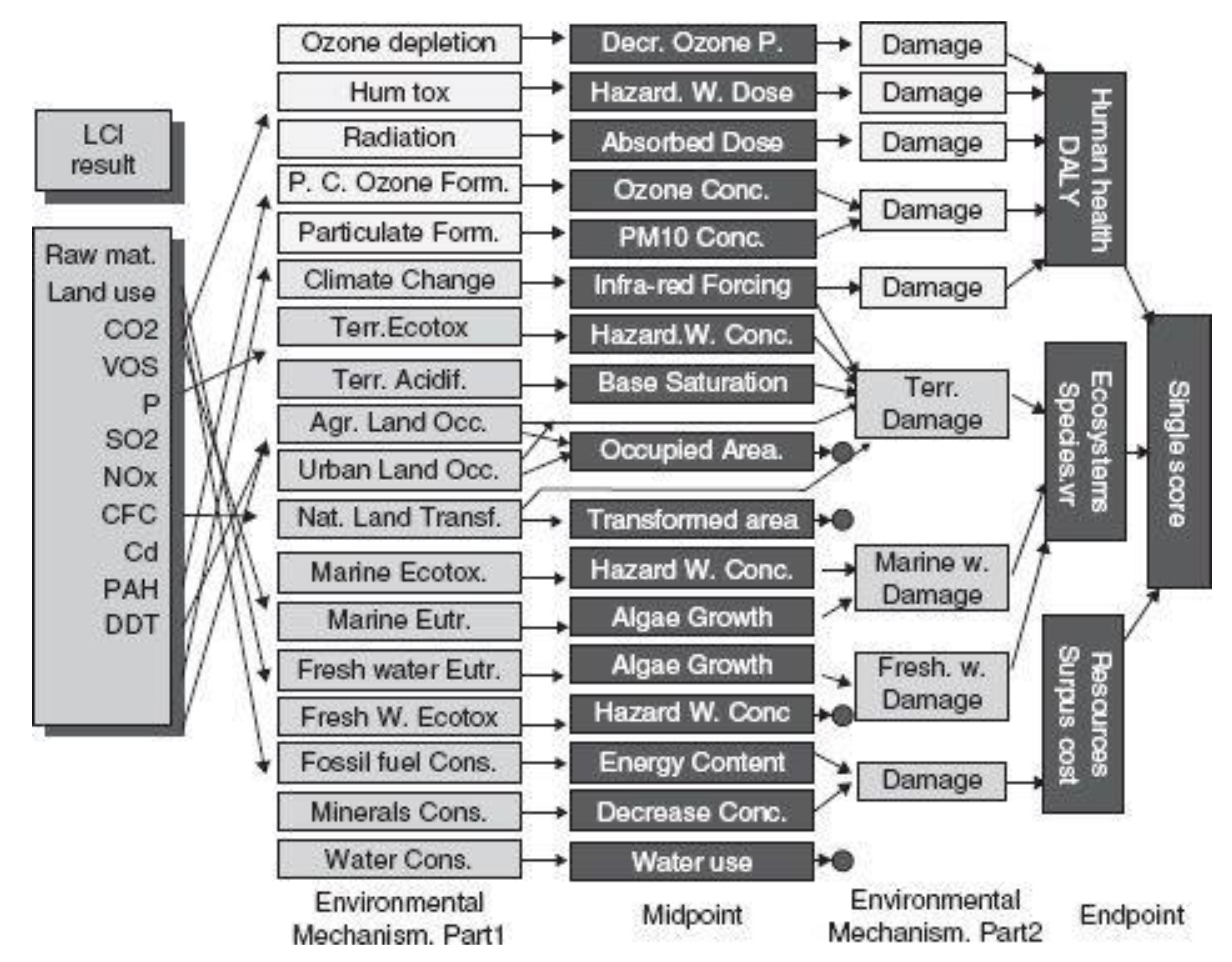

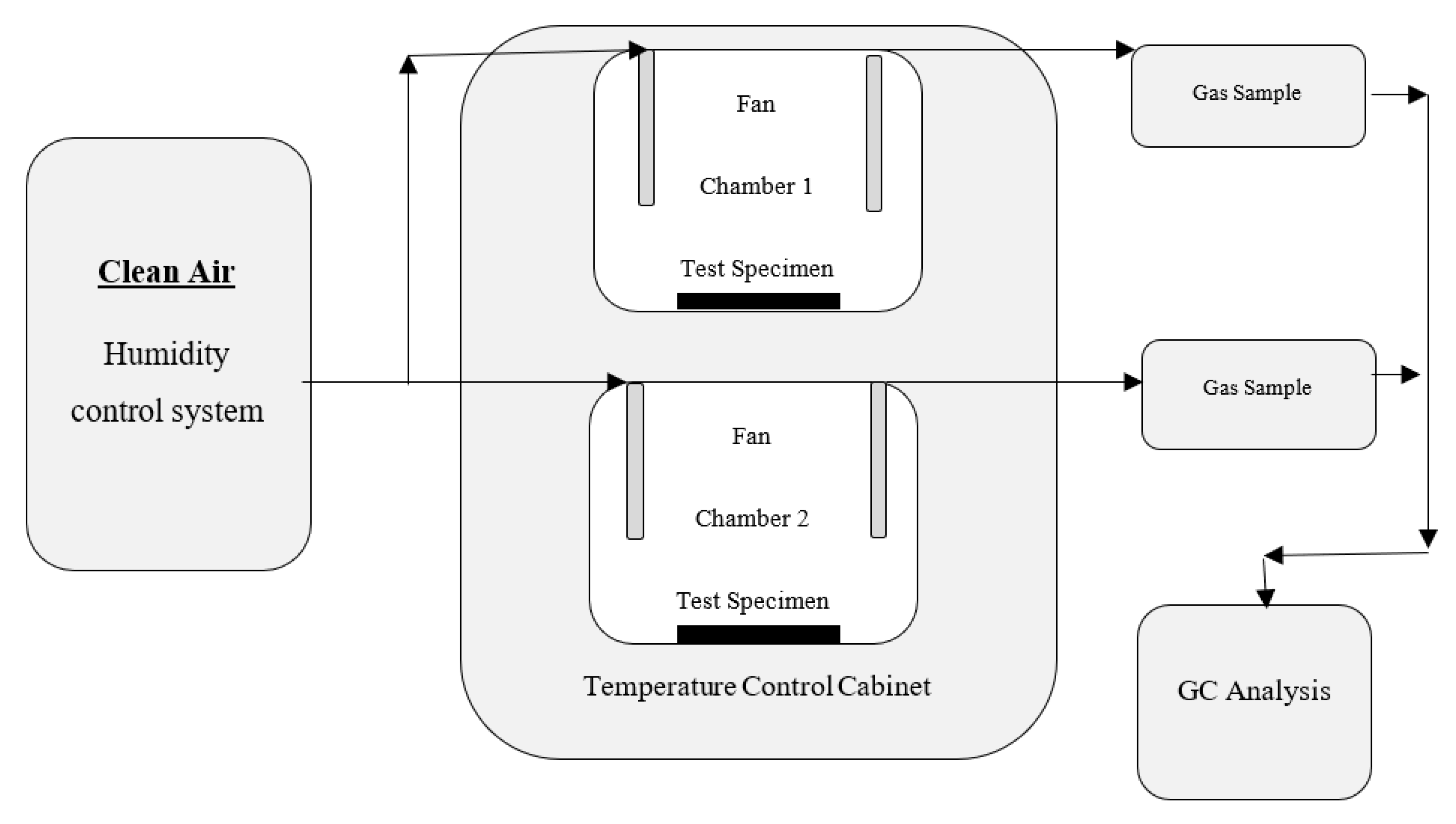

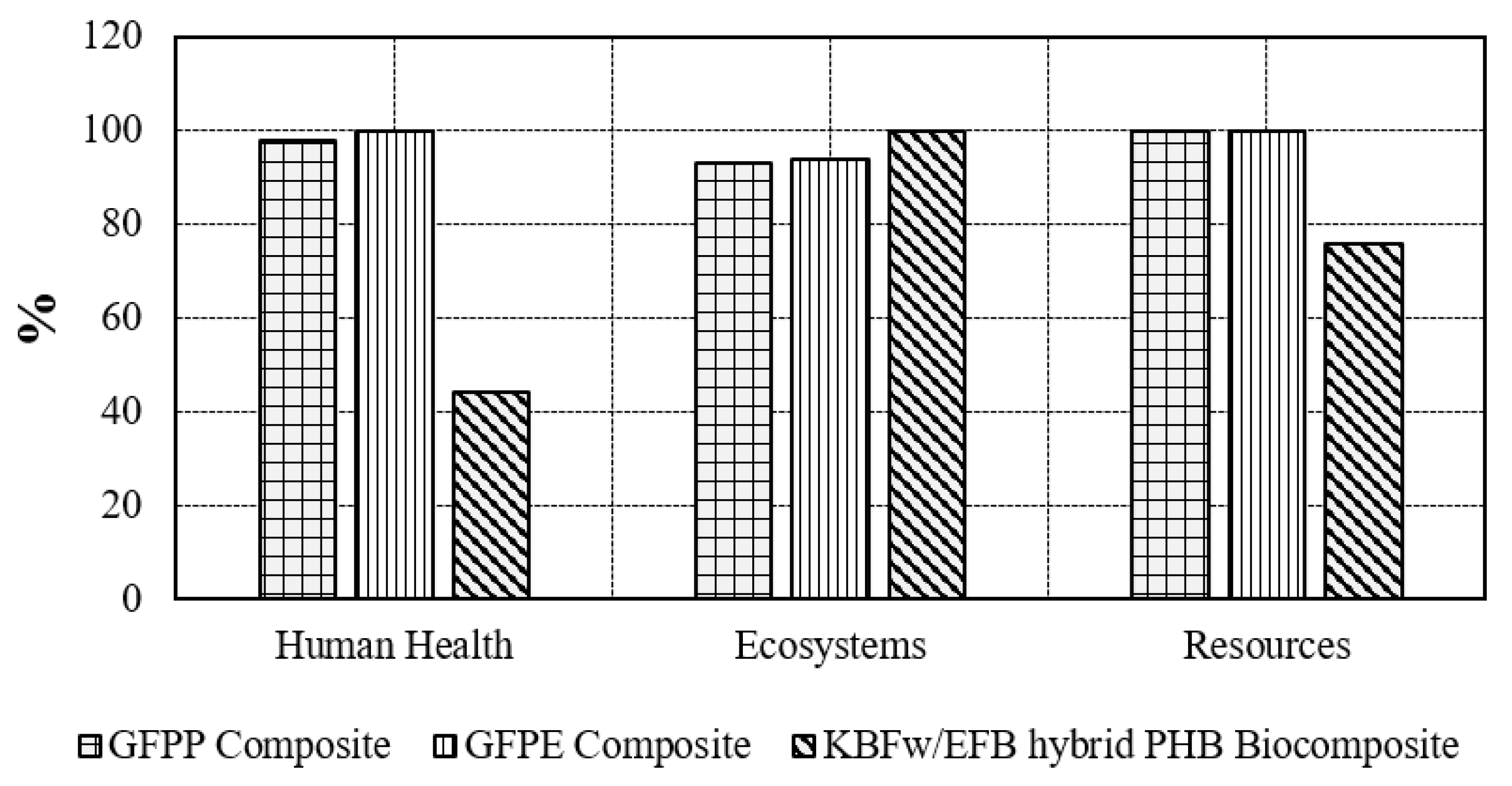

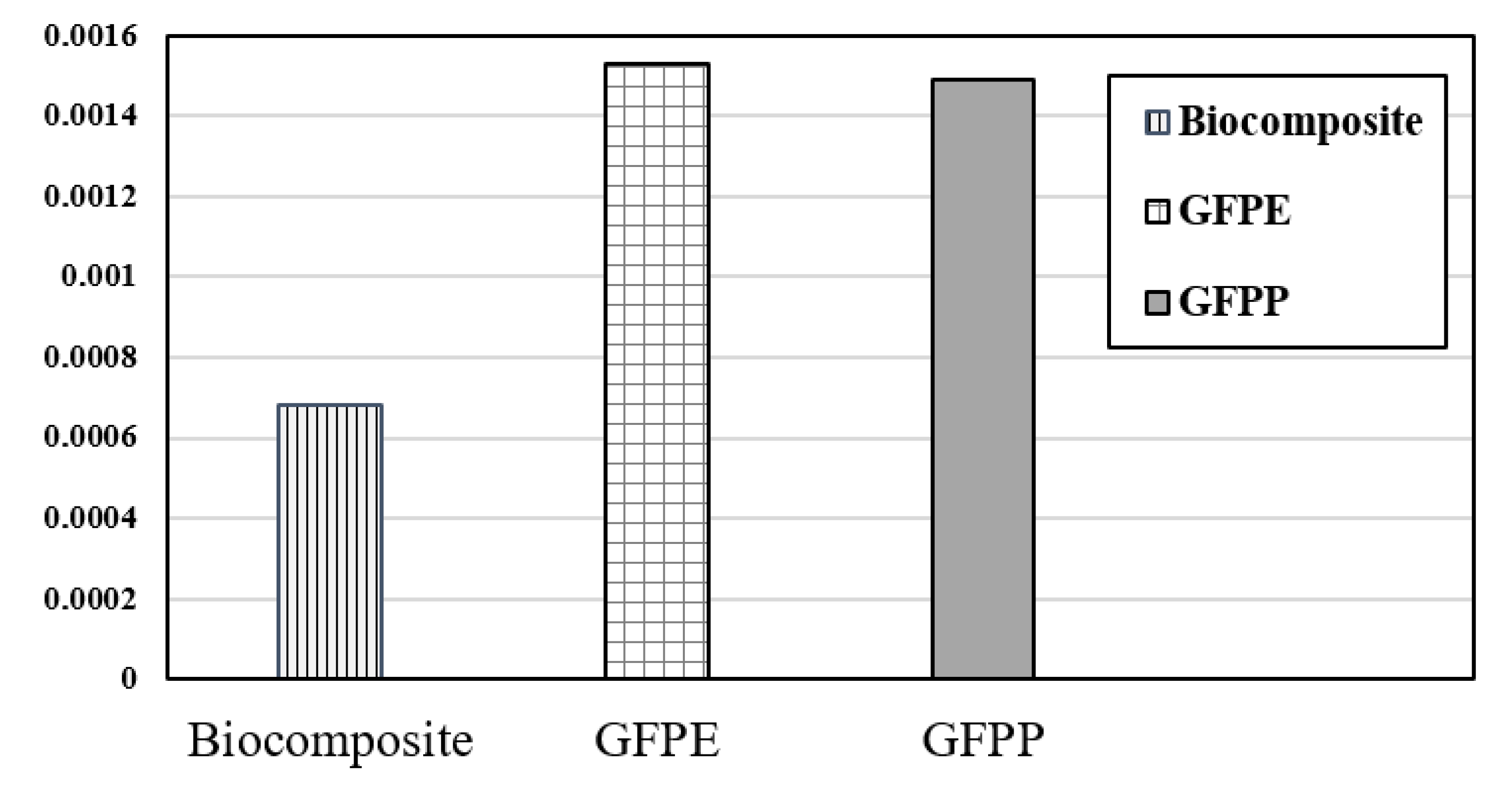

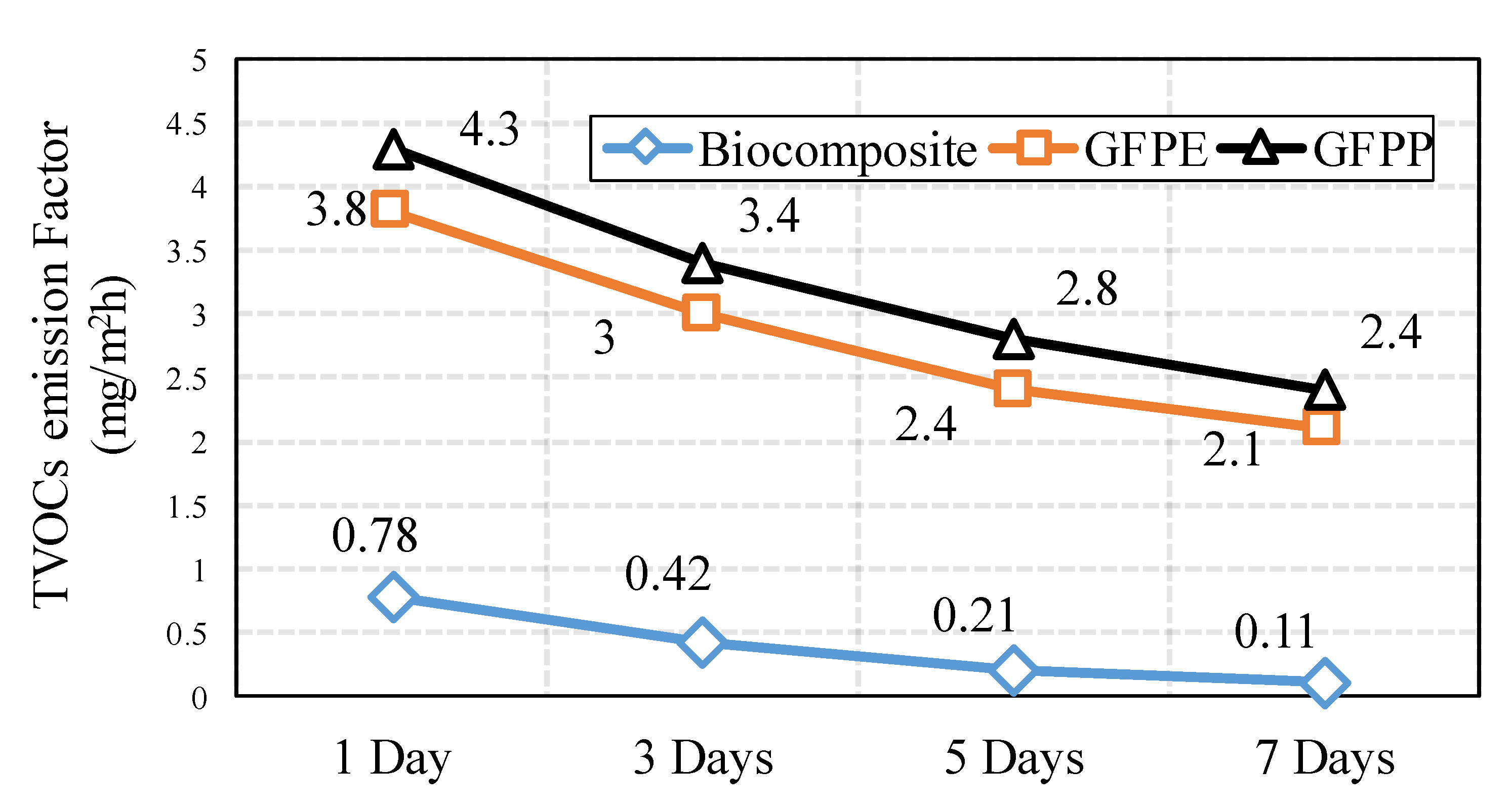
| No. | Biocomposite | Results | References |
|---|---|---|---|
| 1 | Hemp fiber/cellulose acetate composites | Examined the base for rheological, thermal, and morphological characteristics | [48] |
| 2 | Hemp fiber/cellulose acetate composites | Examined base for physico-mechanical and thermo-mechanical properties | [49] |
| 3 | Hemp-reinforced biocomposites | Comparable properties with wood and woody products in construction industry | [48,49,50] |
| 4 | Hemp cellulose acetate/PHB biocomposites | Have mechanical properties similar to structural wood | [50] |
| 5 | PHB and various co-polymers of PHB combined with hemp fiber | Show promise for use in construction due to their good mechanical characteristics. They emphasized that biocomposites have the potential to be used for scaffolding, formwork, flooring, walls, and for many other applications within buildings, as well as temporary construction. | [51,52] |
| 6 | PHB and various co-polymers of PHB combined with flax fiber | [53,54] | |
| 7 | PHB and various co-polymers of PHB combined with jute fiber | [55,56] | |
| 8 | PHB and various co-polymers of PHB combined with kenaf fiber | [57] |
| No. | Country | Organization | Web Address |
|---|---|---|---|
| 1 | Worldwide | World Health Organization | http://www.who.int/en/ |
| 2 | U.S. | U.S. Environmental Protection Agency | http://www.epa.gov/ |
| 3 | Canada | Health Canada | www.hc-sc.gc.ca |
| 4 | Europe | European Commission | http://ec.europa.eu/index_en.htm |
| 5 | UK | Health and Safety Commission | http://www.hse.gov.uk/ |
| 6 | Australia | National Health and Medical Research Council | https://www.nhmrc.gov.au/ |
| 7 | Singapore | Singapore Indoor Air Quality Guideline | http://www.nea.gov.sg |
| 8 | Malaysia | Department of Occupational Safety and Health | http://www.dosh.gov.my/index.php?lang=en |
| 9 | Korea | Korea Environmental Industry and Technology Institute | http://www.keiti.re.kr/en/index.do |
| 10 | China | State Environment Protection Agency | http://www.sepa.gov.cn/ |
| Pollutants | Negative Effects of Pollutants | |
|---|---|---|
| VOCs | Benzene | Bone marrow damage, thrombopenia, leukopenia, anemia |
| Toluene | Poisonous to the liver, blood, nerve, fatigue, mental storm: strongest toxicity | |
| Xylene | Extremely toxic to the nervous system | |
| Ethylbenzene | High levels of toxicity for the nervous system | |
| Styrene | Acute toxicity, irritating the mucous membrane of the eyeball, shriveling the central nervous system | |
| HCHO | Irritation to the eyes, nose, throat, cough, diarrhea, vertigo, nausea, skin disease, rhinitis, emotional instability, losing memory, damaging the nervous system, carcinogenesis | |
| Properties | PHB | PP | PE |
|---|---|---|---|
| Chemical Resistance | |||
| Acids—dilute Alcohols Alkalis Greases and oils | Fair Fair Poor Good | Good–Fair Good Good Good–Fair | Good Good Good Good–Fair |
| Mechanical Properties | |||
| Elongation at break (%) Izod impact strength (J m−1) Tensile modulus (GPa) Tensile strength (MPa) | 6 35–60 3.5 40 | 150–300 20–100 0.9–1.5 25–40 | 500 >1000 0.2–1.2 20–40 |
| Physical Properties | |||
| Density (g cm−3) Resistance to ultraviolet | 1.25 Fair | 0.9 Poor | 0.94 Poor |
| Thermal Properties | |||
| Upper working temperature (°C) | 95 | 90–120 | 55–95 |
| Biodegradability | Yes | No | No |
| Variables | Condition |
|---|---|
| Chamber volume | 20 L |
| Sample size | (0.15 m × 0.15 m × 2) = 0.045 m2 |
| Air flow rate | 0.01 m3/h |
| Ventilation rate | 0.5 /h |
| Sample loading factor | (0.045 m2/0.02 m3) = 2.25 m2/m3 |
| Temperature | 23 ± 1 °C |
| Relative humidity | 50% ± 5% |
© 2020 by the authors. Licensee MDPI, Basel, Switzerland. This article is an open access article distributed under the terms and conditions of the Creative Commons Attribution (CC BY) license (http://creativecommons.org/licenses/by/4.0/).
Share and Cite
Khoshnava, S.M.; Rostami, R.; Mohamad Zin, R.; Štreimikienė, D.; Mardani, A.; Ismail, M. The Role of Green Building Materials in Reducing Environmental and Human Health Impacts. Int. J. Environ. Res. Public Health 2020, 17, 2589. https://0-doi-org.brum.beds.ac.uk/10.3390/ijerph17072589
Khoshnava SM, Rostami R, Mohamad Zin R, Štreimikienė D, Mardani A, Ismail M. The Role of Green Building Materials in Reducing Environmental and Human Health Impacts. International Journal of Environmental Research and Public Health. 2020; 17(7):2589. https://0-doi-org.brum.beds.ac.uk/10.3390/ijerph17072589
Chicago/Turabian StyleKhoshnava, Seyed Meysam, Raheleh Rostami, Rosli Mohamad Zin, Dalia Štreimikienė, Abbas Mardani, and Mohammad Ismail. 2020. "The Role of Green Building Materials in Reducing Environmental and Human Health Impacts" International Journal of Environmental Research and Public Health 17, no. 7: 2589. https://0-doi-org.brum.beds.ac.uk/10.3390/ijerph17072589






